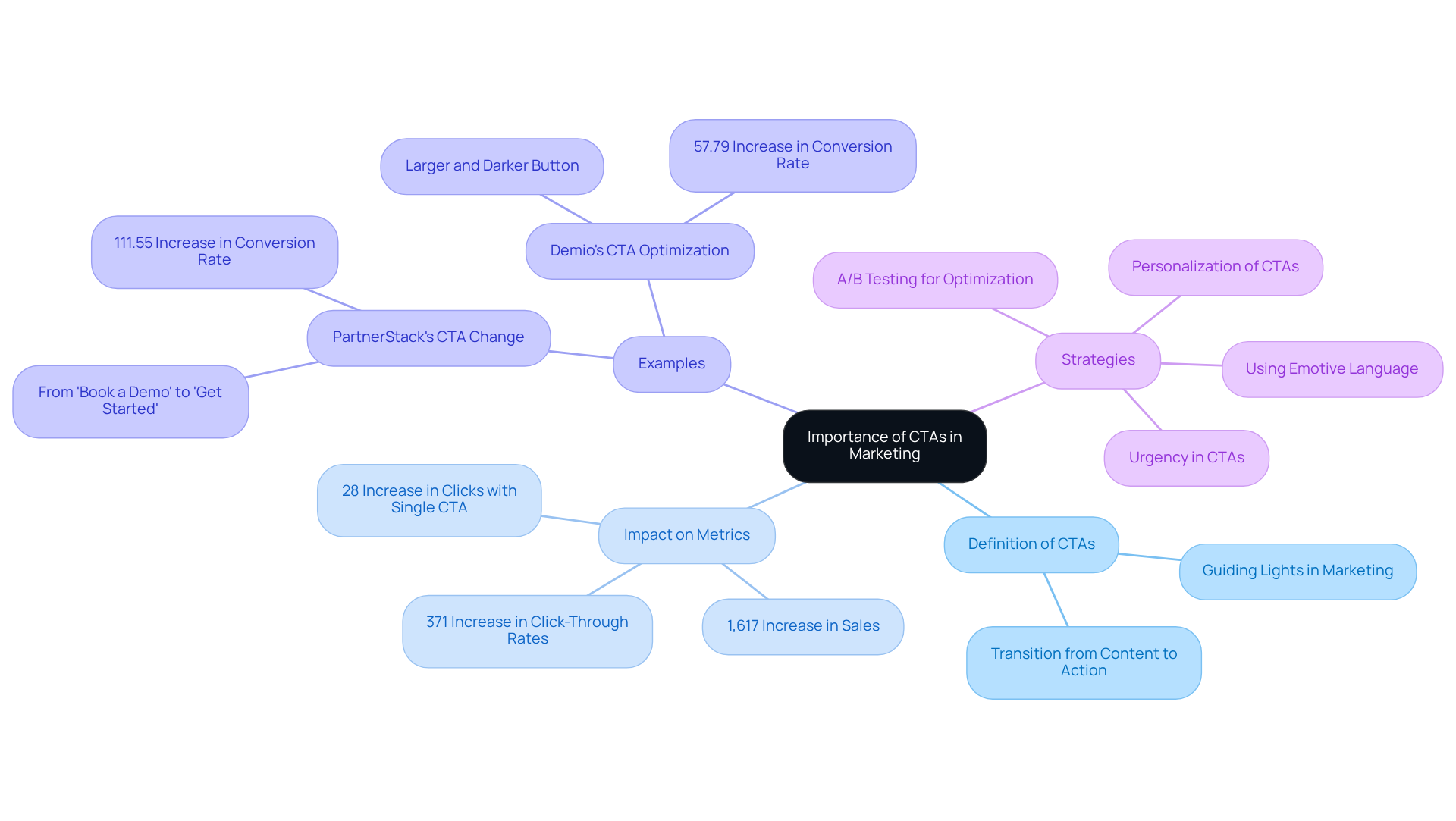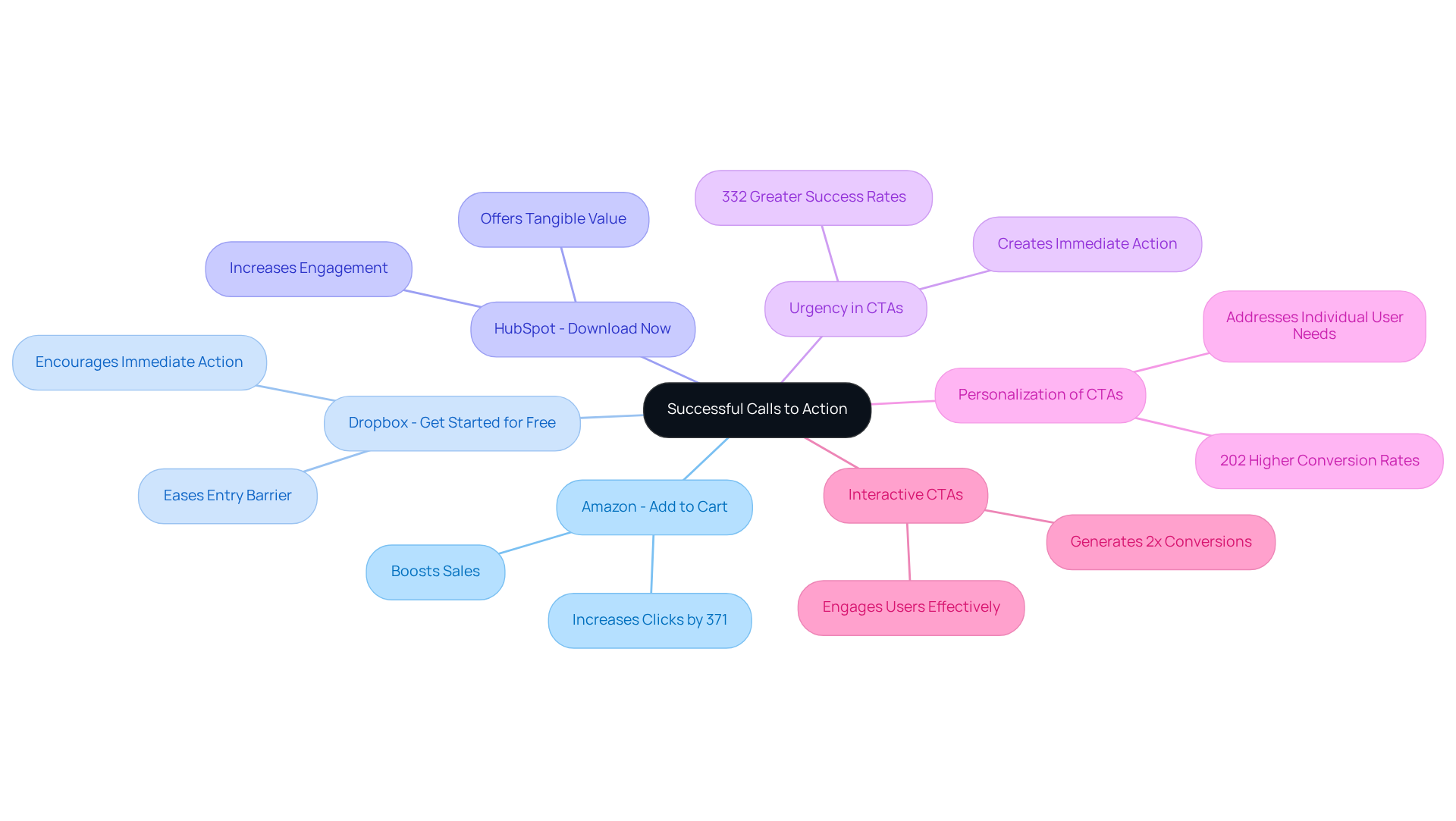Overview
The importance of a call-to-action (CTA) in achieving marketing success cannot be overstated. Many founders face the challenge of engaging their audiences effectively, which can often lead to frustration and missed opportunities.
When crafted with clear language, a sense of urgency, and thoughtful design, effective CTAs can transform this challenge into a pathway for increased engagement and conversions. They not only improve click-through rates and sales but also serve as guiding lights for potential customers navigating the sales funnel.
By understanding the power of CTAs, you can take meaningful steps towards connecting with your audience and driving your success. Remember, it’s about nurturing those connections and guiding your audience with care.
Introduction
In the fast-paced world of digital marketing, the call-to-action (CTA) emerges as a crucial element that can profoundly impact consumer behavior. These concise prompts serve to guide audiences toward taking meaningful steps, whether it’s making a purchase or signing up for a newsletter. Yet, many marketers find themselves grappling with the challenge of crafting effective CTAs, often struggling to resonate with their audience through the right language and sense of urgency. This can leave you feeling frustrated and disconnected from your potential customers.
What if there were strategies to transform ordinary CTAs into powerful tools that not only drive conversions but also nurture lasting relationships with your customers? Together, let’s explore how to create CTAs that truly connect and inspire action.
Define Call-to-Action (CTA)
A call-to-action (CTA), or ctas meaning, is more than just a marketing tool; it’s a vital element that encourages your audience to take meaningful steps, whether that’s clicking a button, signing up for a newsletter, or making a purchase. Often presented as buttons or links within digital content, CTAs are thoughtfully placed to guide individuals toward the next step in their journey with your brand.
However, many struggle with crafting effective CTAs that resonate. Direct phrases like 'Buy Now,' 'Sign Up Today,' or 'Learn More' can feel inviting, yet the language we choose is crucial. In fact, using first-person wording can boost click-through rates by an impressive 90%, underscoring the power of words in connecting with your audience.
The impact of CTAs in digital marketing is profound; emails featuring a single call to action can increase clicks by over 371% and sales by about 1,617%. Personalized CTAs convert 202% more effectively than generic ones, and those tailored to specific industries, interests, or buyer stages can turn 42% more visitors into leads.
Understanding and applying effective CTAs meaning is essential for anyone aiming to enhance their results and foster user engagement. Additionally, incorporating urgency signals can elevate performance by 332%, making it a compelling strategy in CTA design.
For instance, Demio's A/B test on their thank you page revealed a 57.79% higher success rate after they enlarged and darkened their CTA button, illustrating how thoughtful design can make a difference. Embracing these insights can empower you to create CTAs that not only drive action but also nurture relationships with your audience.
Explain the Importance of CTAs in Marketing
The ctas meaning is essential in marketing, acting as guiding lights that help potential customers navigate the often overwhelming sales funnel. They create a seamless transition from consuming content to taking meaningful actions, which reflects the ctas meaning that lead to sales.
Imagine receiving an email that not only captures your attention but also gently nudges you toward a decision. Strategically placed calls to action in email campaigns can significantly boost website traffic and conversions. In fact, research shows that emails featuring a single, clear call to action can increase click-through rates by over 371% and sales by approximately 1,617%. Additionally, emails with a single CTA button see a 28% increase in clicks compared to those with text links.
With the typical attention span of a website visitor being just 8 seconds, it becomes even more crucial to understand ctas meaning for having clear and engaging calls to action. Effective calls to action, or ctas meaning, also empower marketers to assess campaign performance through clear metrics on interactions, enabling data-informed adjustments and improvements. This capability is particularly vital for technology startups, where well-crafted calls to action can enhance audience engagement and lead to significant increases in success rates.
By integrating emotive language within calls to action, startups can further inspire individuals to convert, making it essential to tailor their messaging. A compelling example is PartnerStack, which saw a remarkable increase in engagement rates after changing its CTA from 'Book a Demo' to 'Get Started.' This illustrates how straightforward yet impactful wording can make a difference.
Remember, your calls to action can be the bridge that connects your audience to the solutions they seek.

Identify Key Characteristics of Effective CTAs
Effective calls to action, which are often referred to as ctas meaning, are essential for driving user engagement, yet many struggle to achieve their full potential. The problem lies in the lack of clarity and urgency that often accompanies these prompts. When calls to action are not clear and concise, the desired action can become lost in ambiguity. Imagine the difference it could make if straightforward language was used to communicate the action needed. Action-oriented phrases can significantly enhance success rates—by as much as 122%.
Moreover, establishing a sense of urgency is crucial. Expressions like 'Limited Time Offer' or 'Act Now' can encourage prompt responses, potentially boosting results by 332%. This urgency not only captures attention but also speaks to the need for immediate action, which many startup founders can relate to.
The visual design of the CTA also plays a vital role. A visually appealing and distinct CTA, achieved through contrasting colors and strategic placement, can draw users in. Research shows that red calls to action can outperform green ones by 21%, highlighting the importance of color psychology in engaging your audience.
Additionally, simplifying the user experience by limiting form fields to three or fewer can enhance opportunities for engagement. This clarity is essential, especially in a fast-paced environment where every moment counts.
Lastly, it’s important that calls to action align with the overall messaging of your campaign. This consistency reinforces the value proposition presented to your audience, fostering a sense of trust and reliability. By focusing on these key traits, marketers can create effective calls to action, which is often referred to as ctas meaning, that not only boost audience involvement but also lead to greater success rates. Remember, nurturing your audience's needs and emotions is key to fostering lasting connections.
Provide Examples of Successful CTAs
The ctas meaning is important because effective calls to action are vital across various platforms and sectors, as they play a crucial role in enhancing audience engagement and conversions. Many of us have felt the frustration of a lackluster response from our audience. It can be disheartening when our efforts don’t yield the desired results.
For instance, Amazon's 'Add to Cart' button stands out as a clear and compelling CTA that encourages immediate action, significantly boosting their sales. Similarly, Dropbox eases the entry barrier with its 'Get Started for Free' CTA, inviting individuals to register for their service without hesitation. In the realm of email marketing, HubSpot often employs calls to action such as 'Download Now' and 'Get Your Free Guide.' These not only prompt action but also offer tangible value to the user.
Did you know that 43% of marketers use one CTA per email? This simple strategy can increase clicks by an impressive 371% and sales by 1,617%. The ctas meaning refers to expertly crafted calls to action that have been shown to significantly improve engagement rates. For instance, changing a vague prompt from 'Learn More' to 'View pricing' raised clickthrough rates from 2% to 5%.
These insights highlight the importance of strategic CTA design in marketing efforts, emphasizing the ctas meaning as an essential tool for marketers looking to enhance their engagement and transformation strategies. Moreover, incorporating urgency into calls to action can lead to 332% greater success rates, underscoring the importance of urgency in CTA design. Furthermore, adding interactive elements to CTAs, like quizzes or polls, can generate twice as many conversions compared to standard CTAs. This showcases the effectiveness of engaging users through innovative approaches.
We encourage you to reflect on your current strategies and consider how these insights can foster deeper connections with your audience.

Conclusion
In the realm of marketing, the challenge of crafting effective calls-to-action (CTAs) can often feel overwhelming. Many marketers struggle with transforming simple prompts into engaging invitations that truly resonate with their audience. This struggle can lead to missed opportunities for meaningful interactions and increased conversions, leaving brands feeling disconnected from their consumers.
As we reflect on the importance of clarity, urgency, and emotional connection in CTAs, it becomes clear that these elements are not just strategies—they are essential to fostering genuine engagement. The staggering impact of personalized and thoughtfully designed CTAs cannot be overlooked. When we consider real-world examples of successful implementations, it’s evident that a well-crafted CTA can significantly enhance engagement and drive results. By integrating urgency and visually appealing design, we can ensure that potential customers feel a genuine urge to take action.
In today’s rapidly evolving digital landscape, the strategic use of CTAs is more critical than ever. We encourage you to take a moment to reflect on your current practices. Embracing the strategies we’ve discussed can help you create CTAs that not only prompt immediate action but also nurture long-term relationships with your audience. By prioritizing the development of engaging and effective CTAs, you can unlock the potential for greater success in your marketing endeavors, ultimately leading to a more connected and responsive consumer base. Together, let’s build a marketing strategy that resonates deeply and fosters lasting connections.
Frequently Asked Questions
What is a call-to-action (CTA)?
A call-to-action (CTA) is a vital element in marketing that encourages the audience to take meaningful steps, such as clicking a button, signing up for a newsletter, or making a purchase. CTAs are often presented as buttons or links within digital content to guide individuals toward the next step in their journey with a brand.
Why is the language used in CTAs important?
The language used in CTAs is crucial because it can significantly impact engagement. Direct phrases like "Buy Now," "Sign Up Today," or "Learn More" can be inviting, and using first-person wording can boost click-through rates by up to 90%.
What impact do CTAs have on digital marketing?
CTAs have a profound impact on digital marketing. Emails with a single call to action can increase clicks by over 371% and sales by about 1,617%. Personalized CTAs convert 202% more effectively than generic ones, and tailored CTAs can turn 42% more visitors into leads.
How can urgency signals affect CTA performance?
Incorporating urgency signals in CTAs can elevate performance by 332%, making it a compelling strategy in CTA design.
Can the design of a CTA influence its effectiveness?
Yes, the design of a CTA can significantly influence its effectiveness. For example, Demio's A/B test showed a 57.79% higher success rate after they enlarged and darkened their CTA button, demonstrating how thoughtful design can make a difference.
What should one understand to create effective CTAs?
To create effective CTAs, one should understand the meaning and application of CTAs, the importance of language, the impact of personalization, and the benefits of incorporating urgency and thoughtful design.




